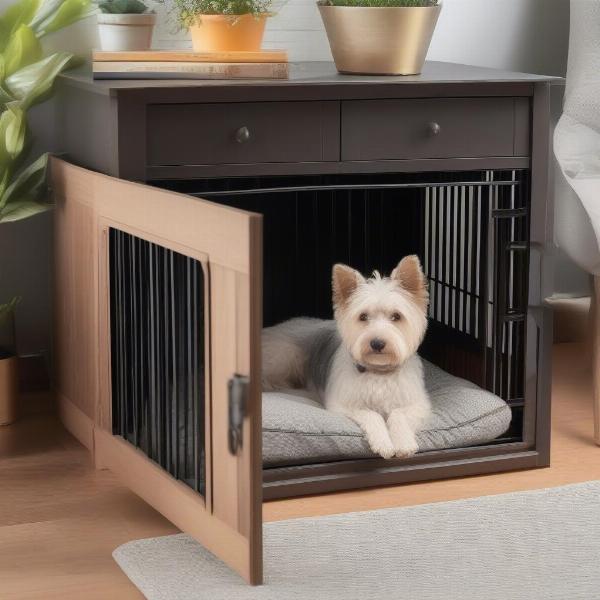A dog crate can be a haven for your furry friend, a safe space for relaxation and rest, or a helpful tool for housetraining. But what exactly should you put inside to make it comfortable and inviting? This guide covers everything you need to know about setting up the perfect dog crate environment, whether you have a puppy, an adult dog, or a senior.
Essential Dog Crate Items
A comfortable and inviting crate is key to a positive crate training experience. Here are the must-haves:
-
A Comfortable Bed: This is arguably the most important item. Choose a dog bed that fits snugly inside the crate, leaving enough room for your dog to stand, turn around, and lie down comfortably. Soft, washable beds are ideal. Avoid beds with small parts that could be chewed off and swallowed.
-
Food and Water: If your dog spends extended periods in the crate, providing fresh water is essential. A crate-safe water bowl that attaches to the side is a good option. You can also offer food in the crate, especially during initial crate training, to create positive associations.
 Dog crate with comfortable bed and water bowl
Dog crate with comfortable bed and water bowl -
Safe and Durable Toys: Toys help keep your dog entertained and prevent boredom, especially when they’re alone. Choose durable chew toys made from non-toxic materials. Avoid toys with small parts, squeakers that can be removed, or anything that could pose a choking hazard. Rotating toys regularly will keep your dog interested and engaged.
Making the Crate a Home Away From Home
Beyond the essentials, there are other ways to personalize the crate and make it even more appealing:
- Blankets or Soft Bedding: A soft blanket can add an extra layer of comfort and warmth, especially for dogs who like to burrow. Choose washable blankets and avoid those with loose threads or fringe that could be ingested.
- Something That Smells Familiar: A worn t-shirt or blanket with your scent can comfort your dog and help them feel more secure, especially during the initial stages of crate training. This is particularly helpful for puppies adjusting to their new home.
What NOT to Put in a Dog Crate
While it’s important to make the crate comfortable, certain items should be avoided:
- Unsafe Toys: As mentioned earlier, avoid toys with small parts, squeakers that can be removed, or anything that could be a choking hazard.
- Collars and Harnesses: These should be removed while your dog is in the crate to prevent entanglement and potential strangulation.
- Household Chemicals or Cleaners: Keep all cleaning products and chemicals safely out of reach of your dog, including in areas near the crate.
- Too Many Items: Overcrowding the crate can make it feel less like a den and more like a storage space. Stick to the essentials and a few comfort items.
Crate Training Tips: Creating a Positive Experience
-
Introduce the crate gradually: Don’t force your dog into the crate. Let them explore it at their own pace and associate it with positive experiences.
-
Use positive reinforcement: Reward your dog with treats and praise when they enter the crate calmly.
-
Start with short periods: Gradually increase the time your dog spends in the crate.
-
Never use the crate as punishment: The crate should be a safe and positive space, not a place for punishment.
Conclusion
Creating a comfortable and safe crate environment is essential for successful crate training and a happy dog. By carefully selecting the right items and following positive reinforcement techniques, you can help your furry friend see their crate as a welcoming retreat. Remember to always prioritize safety and comfort when choosing what to put inside.
FAQ
- How big should my dog’s crate be? Your dog should be able to stand, turn around, and lie down comfortably in their crate.
- Can I leave my dog in the crate overnight? Yes, once your dog is fully crate trained, they can comfortably sleep in their crate overnight.
- What if my dog cries in the crate? It’s normal for dogs to whine or cry initially. Avoid letting them out immediately, as this can reinforce the behavior.
- How often should I clean my dog’s crate? Clean the crate regularly, especially if accidents occur. Wash bedding weekly.
- Can I use a crate for an older dog? Yes, older dogs can benefit from the security and comfort of a crate, especially if they are experiencing anxiety or mobility issues.
- What kind of toys are best for a crate? Durable chew toys made from non-toxic materials are ideal.
- Should I cover the crate? Some dogs prefer a covered crate, as it creates a more den-like environment. Experiment to see what your dog prefers.
ILM Dog is your trusted resource for expert advice on dog care and training. We provide comprehensive information on dog breeds, health, nutrition, behavior, and much more. Explore our website at ILM Dog for valuable resources to help you provide the best care for your canine companion. Contact us today for personalized advice! Email: [email protected], Phone: +44 20-3965-8624.